Bijapur Fort - Overview
Bijapur fort was constructed by Yusuf Adil Shah who belonged to the Adil Shahi dynasty. The fort consists of many monuments like palaces, mosques, tombs and many others. Different rulers of this dynasty built the structures inside the fort.

Bijapur
The city of Bijapur was established by Kalyani Chalukyas during their ruling period between 10th and 11th centuries AD and the city was called Vijaypura. Later, the city came under the rule of Bahmani kingdom who ruled for almost 200 years. The city was also ruled by the kings of Delhi Sultanate, Mughals, Marathas and British.

Visiting Hours
Bijapur Fort is opened for public from 10:00am to 6:00pm. The fort is opened for the public on all days of the week but is closed on public holidays. It takes around 2-3 hours to visit the fort as there are many monuments to see inside the fort.
Tickets
The tourists have to buy tickets in order to visit the Bijapur fort. Tourists who belong to India, SAARC members, and BIMSTEC members have to pay Rs. 15 while the tourists from other countries have to pay Rs. 200.
Best time to visit
Best time to visit the fort is the period between September and February as the climate is very pleasant. Even the months of December and January are also not very cold. In the rest of the months, the climate is hot and is not suitable to visit the fort.
Where to Stay?
There are only 26 hotels in Bijapur which range from inexpensive hotels to three-star hotels. Some of the hotels in the city are as follows −
- Three–Star Hotels
- Hotel Kanishka International located at Station Road
- Hotel Basava Residency located at Mukund Nagar, Station Road
- Hotel Golden Heights located at Station Road
- Hotel Sri Udupi Park located at Station Road
- Budget or Two-Star Hotels
- Pleasant Stay located at Solapur Road
- Hotel Ashoka residency located at Solapur Road
- Hotel Shashinag Residency located at Solapur Road
- Hotel Pearl located opposite Gol Gumbaz
- Hotel Ishwar located at Jaishree Talkies, Kamnaji Bazar
- Cheap Hotels or One–Star Hotels
- Hotel Megharaj located at Station Road
- Hotel Madhuvan International located at Station Road
- Hotel Santosh Lodge located opposite Central Bus Station
- Hotel Madhura Residency located at Station Road
- Shubhashree Comfort Lodging located at Solapur Lodge
Bijapur Fort - History
The city of Bijapur was first ruled by Kalyani Chalukyas during the period of 10th and 11th centuries and the city was known as Vijaypura. In 13th century, the kings of Khilji dynasty ruled the city. The rulers of Bahmani sultanate of Gulbarga captured Bijapur in 1347AD and the city was renamed as Bijapur.
Bijapur Fort under Yusuf Adil Shah
Yusuf Adil Shah was the son of Sultan of Turkey and was purchased by Mahmud Gavan, prime minister of Bidar. At that time Bidar was ruled by Sultan Muhammad III. Yusuf showed bravery and loyalty to protect the sultanate and so he was given the governorship of Bijapur.
Yusuf built Arkilla fort or Bijapur Fort and Faroukh Mahal whose designers were brought from Persia, Turkey, and Rome. Later, Bahmani kingdom was divided into five small kingdoms and Bijapur was one of them. Seeking the opportunity, Yusuf declared himself the ruler of Bijapur and established Adil Shahi dynasty.
Bijapur Fort under Ibrahim Adil Shah
Ibrahim Adil Shah succeeded Yusuf Adil Shah in 1510. Ibrahim was a minor when his father died so his mother ruled the kingdom and fought the enemies who wanted to capture Bijapur. Ibrahim built Jami masjid within the fort.
Bijapur Fort under Ali Adil Shah I
Ali Adil Shah I succeeded Ibrahim Adil Shah. He constructed his tomb called Ali Rouza along with Gagan Mahal and Chand Bawdi. Ali also did not have a son so his nephew Ibrahim II succeeded. Since Ibrahim was a minor so the kingdom was protected by Chand Bibi.

Bijapur Fort under Ibrahim II
Ibrahim II was a good ruler who created harmony between Hindus and Muslims and between Shia and Sunni Muslims. That’s the reason the king came to be known as Jagadguru Badshah. The king built many temples and he was also the builder of Gol Gumbaz. A gun was developed during his reign whose length is 4.45m. During the last days of his life, his wife Bariba ruled the kingdom.

Bijapur Fort under Adil Shah II
Adil Shah II was the adopted son and successor of Ibrahim II. Due to the problem of successorship internally, the kingdom was weakened. This led to the defeat of Afzal Khan by Maratha ruler Shivaji who plundered the city 11 times. Shivaji signed a treaty to stop the capturing of Karnataka. After his death, Aurangzeb attacked and captured Bijapur in 1686.

Bijapur Fort - Architecture
Bijapur fort is a very big fort with many structures inside. The fort was built in 1565 by the founder of the Adil Shahi dynasty. There are 96 bastions of various designs within the fort. Spaces were provided within the bastions to drop stones or cannons. These spaces are known as crenulations and machicolations. There are five main gates of the fort and each has ten bastions. A moat surrounds the fort which was made so that enemy could not enter the fort. The moat has the width of 50 feet.
Gates of the Fort
The fort can be entered through five gates which are located in every direction. The gates with their directions are as follows −
- Makka gate in the west
- Shahpur gate in the northwest
- Bahmani gate in the north
- Allahpur gate in the east
- Fateh gate in the southeast

Jamia Masjid
Jamia Masjid is located in the southeast direction of the fort. The construction of the mosque was started in 1565 but could not be completed. The arcaded prayer hall has aisles having a dome with nine bays. The aisles are supported on pillars. The mosque also has a large courtyard with water tank. The mosque is also known as Jumma Masjid as khutba or speech related Islamic traditions is read on every Friday.
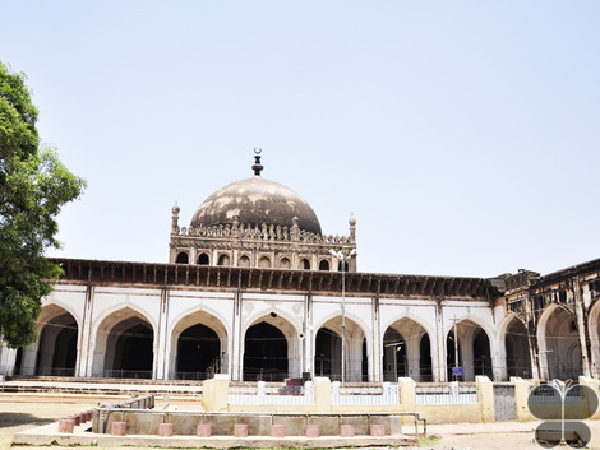
The area covered by the mosque is 10810m2. The rectangular-shaped mosque has the dimensions of 170m x 70m. There are nine arches and five arches are within them that divide the mosque into 45 compartments. There are 2250 tiles which are laid in the form of a prayer mat. The tiles were constructed by Aurungzeb.
Ibrahim Rauza or Ibrahim Tomb
Ibrahim Rauza was built in 1627 and has the graves of Ibrahim Adil Shah II and Queen Taj Sultana, his wife. The tomb is built in the form of twin buildings with carvings. Malik Sandal, the architect of this tomb, is also buried here. There is a mosque and a garden inside the tomb that face each other.
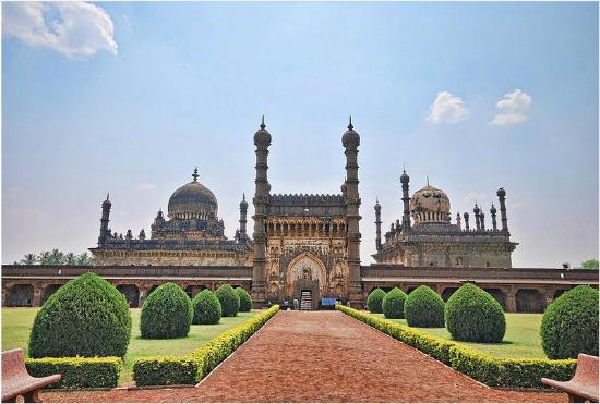
The size of the garden is about 140m2. The ceiling of the tomb is divided into nine squares whose sides are curved. There are four minarets, one on each corner of the tomb. Tourists can reach the tomb through the steps provided below the platform on which the tomb is situated. The mosque in the tomb has gateways made up of teak wood and are decorated with metal strips.
Mehtar Mahal
Mehtar Mahal was constructed in 1620 whose gate is built in Indo-Saracenic style. There is a mosque inside the mahal called Mehtar Mosque which has three storeys. The minarets of the mahal are carved with rows of swans and birds. The mahal has flat roof and the minarets have rounded tops.
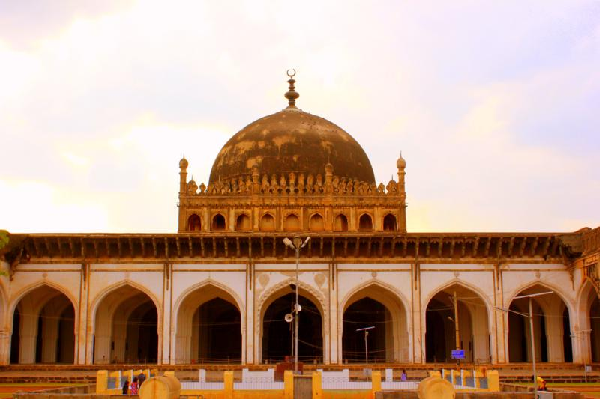
Barakaman
Barakaman was built in 1672 as a tomb for Ali Roza. Previously, the structure was known as Ali Roza but later its name was changed to Barakaman by Shah Nawab Khan. Barakaman has 12 arches and was built during the reign of Shah Nawab Khan. The structure was built on a raised platform and covers an area of 66m2. The arches were built by using black basaltic stone. Ali Roza, his queens and some other ladies are buried in the tomb.
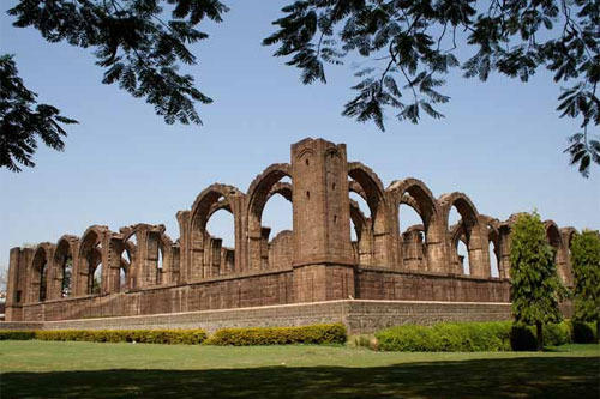
Malik-e-Maidan
Malik-e-Maidan was constructed by Ibrahim Adil Shah II after the battle of Talikota. The structure is also known as Burj-e-Sherz. It has a large cannon having length of 4.45m and diameter of 1.5m. The weight of the cannon is 55 tonnes. The gun remains cool even during summers and produces sound when tapped.
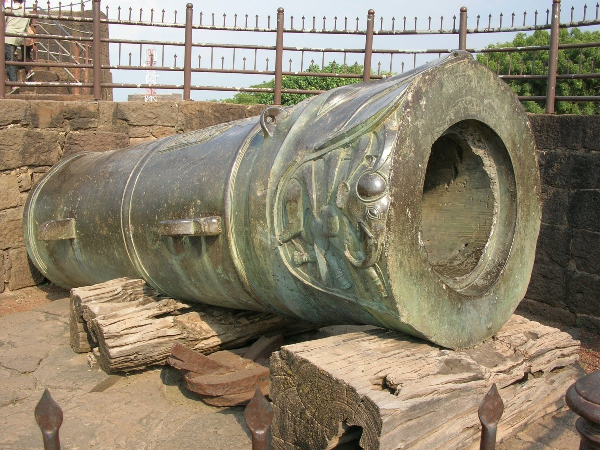
Gagan Mahal
Adil Shah I built the Gagan Mahal or Heavenly Palace in 1561. The palace has three arches out of which the central arch is the widest. The palace has ground and first floor which are now ruined. The ground floor had a darbar hall while the first floor had private residences.
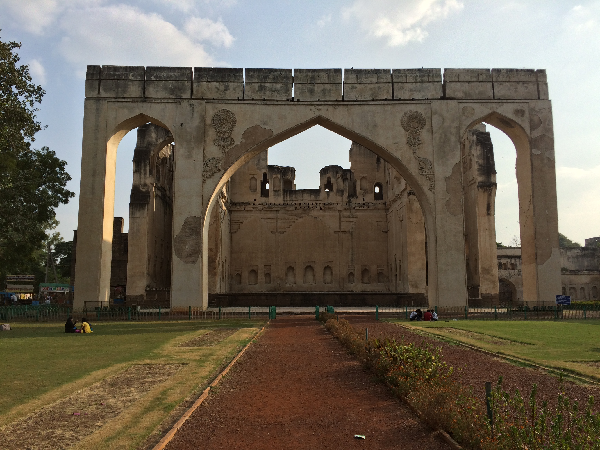
Sat Manzil or Seven Storey
Sat Manzil was a seven storey palace which was built by Ibrahim Adil Shah II in 1583. Currently only five floors are there.
Asar Mahal
Asar Mahal is can be found on the east of the citadel and was built in 1646. The palace is connected to the fort through a bridge. It was also used as a court so it was called Dad Mahal. It is also considered as a shrine as it is believed that it has two hairs of Prophet Muhammad. There are four octagonal columns with ceiling having wooden panels. Women are not allowed to enter the palace.

Taj Bawdi
Taj Bawdi was built in the memory of Taj Sultana who was the first wife of Ibrahim Adil Shah. II. The bawdi has octagonal towers whose east and west wings were used as rest houses.
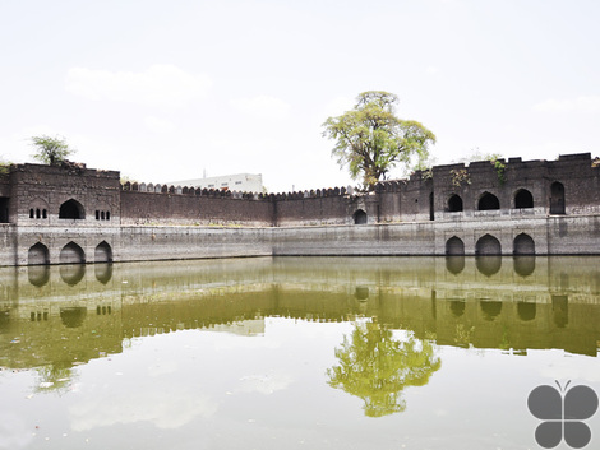
Bijapur Fort - How to Reach?
Bijapur fort is located in the city of Bijapur which is connected to many cities by road and rail network. The city does not have airport but the government is planning to build one in near future. The nearest airport is the Sambre airport located in Belgaum which is around 213km away from Bijapur.

The cities nearby Bijapur with their distance are as follows −
- Bijapur to Hubbali
- By rail – 249km
- By road – 198km
- Bijapur to Solapur
- By rail – 110km
- By road – 98km
- Bijapur to Badami
- By rail – 124km
- By road – 119km
- Bijapur to Gulbarga
- By rail – 223km
- By road – 166km
- Bijapur to Daund
- By rail – 297km
- By road – 284km
- Bijapur to Bellary
- By rail - 341km
- By road – 265km
- Bijapur to Bagalkot
- By rail – 97km
- By road – 83km
- Bijapur to Begaum
- By rail – 391km
- By road – 213km
By Air
Bijapur does not have an airport but the government has planned to construct it in order to increase the tourism. The nearest airport is the Sambre airport located at Belgaum and is around 213km away from Bijapur. Sambre airport is well connected to Mumbai and Bangalore. Tourists can come to Belgaum through flight and can reach Bijapur through rail or road transport.
By Train
Bijapur has railway station where very few trains stop as there are not many trains on this route. The trains connect Bijapur to various cities like Mumbai, Hyderabad, Pune, Varanasi, Bikaner and other places.

By Road
The bus stand of Bijapur is located on MG Road and connects Bijapur to many nearby cities. These places include Aihole, Badami, Hubli, Hampi, Bangalore, and many others. Bijapur is connected to these cities through highway number 13.

Local Transport
Bijapur is a historical place and many tourists daily come here to visit those spots. There are various modes of local transport which the tourists can hire in order to visit local places in Bijapur. These include tongas, motorcycle on rent, and auto rickshaws. Travelling around the city by a tonga is a good experience for the tourists. Tourists can hire motorcycle on rent from main bus stand and this mode of transport is cheaper than the other two. Tourists can get auto rickshaws easily to visit the city.
Bijapur Fort - Nearby Places
Bijapur is popular for many historical places and beside the fort, tourists can also visit many other places like tombs, temples, dams etc. Here some of the popular places have been discussed which the tourists can visit.
Gol Gumbaz
Gol Gumbaz is the tomb of Mohammad Adil Shah. Yaqut of Dabul designed the structure and its construction was completed in 1656. The construction of the monument is based on Deccan architecture. The diameter of the dome is around 124 feet and is considered as the second largest dome in the world.

There are four minarets, one each at the corner and each minaret has eight storeys. If the dome is viewed from inside, there is a balcony with a gallery and if someone speaks or a sound is produced, it echoes seven times. The floor of the tomb has the size of 1700m2 while its diameter of the tomb is 38m. The height of the tomb is 51m.
Almatti Dam
Bijapur is situated on Krishna river and on the same river, Almatti dam was constructed. The dam provides water to Bagalkot, Bijapur, Gulbarga, Raichur, and Koppal. The construction of the dam was completed in 2005. The height of the dam is around 519m.

Jod Gumbaz
Jod Gumbaz is a tomb with two domes. The tomb was made in the memory of Khan Muhammad, and Abdul Razzaq Qadiri. The tomb is situated near Mecca gate and is also known as Two Sisters. The monument was built in 1687 and is also known as the dargah of Abdul Razzaq Qadiri.

Kudalasangama
Kudalasangama is a place of pilgrimage and belongs to the people of Lingayath faith. The pilgrimage center is situated on the confluence of Krishna and Ghatprabha rivers. The government has provided funds to develop the pilgrimage center.

Uppali Buruz
Uppali Buruz is an 80 feet high tower built by Hyder Khan in 1584AD. The structure is spherical in shape and has steps made up of stones. The structure includes guns, war materials, water storage strictures, and other things. The structure is also known as Hyder Burj and Upri Burj. As the tower is very high, tourists can view the city of Bijapur from top of the tower.


Comments
Post a Comment